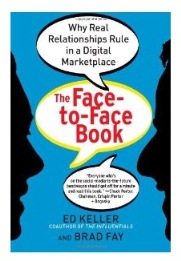The Cluetrain Manifesto Revisited: Past is Prologue, Part 3 - Ed Keller

On May 22, Brad Fay's and my new book, THE FACE-TO-FACE BOOK: Why Real Relationships Rule in a Digital Marketplace, will be published. You can download a free excerpt from the bookhereor buy it onlinehere.
As part of our research we looked at the history of word of mouth and social influence, and were reminded that the past is indeed prologue. Myfirst blog on this topic, reviewed the seminal work of Columbia Professors Paul Lazarsfeld and Elihu Katz – Personal Influence.Part twodiscussed the origins of word-of-mouth advertising in the 1960s and its relevance to today. In this third and final look back I turn to the Cluetrain Manifesto published in 1999.
reminded that the past is indeed prologue. Myfirst blog on this topic, reviewed the seminal work of Columbia Professors Paul Lazarsfeld and Elihu Katz – Personal Influence.Part twodiscussed the origins of word-of-mouth advertising in the 1960s and its relevance to today. In this third and final look back I turn to the Cluetrain Manifesto published in 1999.
We live in the social media age of Facebook, Twitter, and their brethren. Who foretold the current new age?
In 1999, The Cluetrain Manifesto went live. It laid out a vision of how people will live and why business must change in the Internet age. It began with these words: "A powerful global conversation has begun. Through the Internet, people are discovering and inventing new ways to share relevant knowledge with blinding speed. As a result, markets are getting smarter and faster than most companies."
The message for business was that as networked markets learn to speak in a natural and genuine voice that "can't be faked," respect is being lost "for companies unable or unwilling to speak as they do." Cluetrain argued for a shift toward more authentic communications, and away from marketing hype. Companies should talk with consumers, not at them, and they should nurture consumer-to-consumer conversation about their brands as well.
Was Cluetrain correct that we had entered a new era? And was it mainly attributable to the rise of the Internet?
Thesis #1 of The Cluetrain Manifesto set the stage: "Markets are conversations." For most of human history, it declared, people did business face to face, in open markets, where conversation between buyers and sellers was valued and motivating: "The first markets were filled with people, not abstractions or statistical aggregates; they were the places where supply met demand with a firm handshake. Buyers and sellers looked each other in the eye, met and connected. The first markets were places for exchange, where people came to buy what others had to sell -- and to talk."
With the rise of the industrial revolution and then the age of mass media, Cluetrain argued, person-to-person connection was lost, to the detriment of consumers and of business. But with the rise of the Internet, said Cluetrain, people are returning to the "era of conversation." Businesses that seize the opportunity and change will thrive, it argued; those that fight it will struggle. The keys to business success in this new era: "Loosen up. Lighten up. And shut up for a while. Listen for a change. . . .By listening, marketing will re-learn how to talk."
The Cluetrain Manifesto was prescient in many ways, even if it took many businesses almost another decade to become comfortable with the idea of being "open" and "social."
At the same time, Cluetrain was incorrect in one important way. While the internet is making consumer conversations more visible to companies, we actually never left the era of conversation. Consumers have always made their decisions in a social context, and have sought authentic communications with brands. The reason is that people are social animals, whose survival depends on our being not merely the strongest or most aggressive, but on being collaborative. Recent advances in neuroscience, evolutionary biology, psychology and related fields have made it increasingly clear that we are hardwired to be social, and always have been.
For all the impressive growth of online social networks, they are not the Holy Grail of marketing. When looked at in the context of the "total social" opportunity, they are one very small part of the overall picture and needs to be seen as such. And true to John Naisbitt's "high tech, high touch" megatrend, online social networking is no substitute for the power and impact of face-to-face communications. Real world conversations – most of which take place face-to-face – are still the dominant mode of communication by a very wide margin, and they are the most trusted and persuasive.
Today's consumer marketplace is highly social, but not because of particular platforms or technologies. The businesses that will be most successful in the future are the ones that embrace a model that puts people first – rather than technology – at the center of products, campaigns and market strategies. The great social wave we are experiencing today is an opportunity that no business can afford to ignore or look at myopically. It's happening all around us – and much to the continuing surprise of many, it's mostly happening face-to-face, in the real world, with all forms of media and marketing having the opportunity to contribute.
Ed Keller, CEO of theKeller Fay Group, has been called "one of the most recognized names in word of mouth." The publication of Keller's book,The Influentials, has been called the "seminal moment in the development of word of mouth." His new book,The Face-to-Face Book, is coming out in May 2012. You can follow Ed Keller onTwitter,FacebookandGoogle+, or contact him directly at ekeller@kellerfay.com.
Read all Ed’s MediaBizBloggers commentaries at WOM Matters.
Check us out on Facebook at MediaBizBloggers.com
Follow our Twitter updates @MediaBizBlogger
The opinions and points of view expressed in this commentary are exclusively the views of the author and do not necessarily represent the views of MediaBizBloggers.com management or associated bloggers. MediaBizBloggers is an open thought leadership platform and readers may share their comments and opinions in response to all commentaries.


